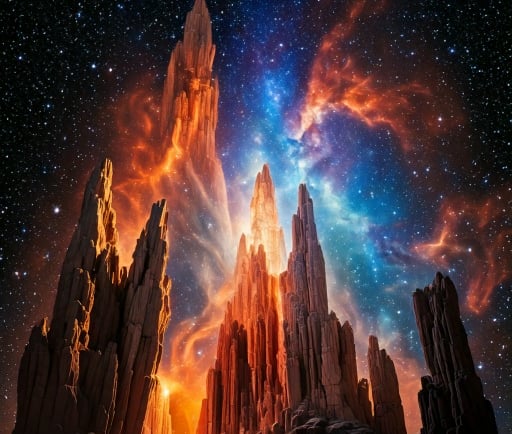Soaring like The Eagle Nebula: The Pillars of Creation


Introduction to the Eagle Nebula
The Eagle Nebula, also referred to as M16, is a spectacular stellar nursery located in the Serpens constellation. This massive nebula is renowned for its awe-inspiring beauty and is home to a young open cluster of stars. The Eagle Nebula stands out in the cosmos, particularly due to its famous structures known as the Pillars of Creation, which resemble enormous stalagmites reaching toward the stars.
The Formation of the Pillars of Creation
Within the Eagle Nebula, the Pillars of Creation are colossal regions of gas and dust, significantly intertwined with the lifecycle of star formation. These pillars can be observed in stunning detail through powerful telescopes, revealing their intricate shapes and the vibrant colors that characterize this celestial wonder. The pillars are comprised primarily of hydrogen gas and dust, representing the raw materials necessary for forming new stars.
As massive stars form within the confines of these pillars, they emit intense radiation and stellar winds which eventually erode the material of the pillars themselves. Over time, this interaction leads to the birth of new stars, continuing a cycle of creation within the nebula. The Eagle Nebula, therefore, is not only a visual delight but also a dynamic environment crucial to our understanding of stellar evolution.
The Significance of the Eagle Nebula in Astronomy
The Eagle Nebula, specifically the Pillars of Creation, holds great significance for astronomers and astrophysicists alike. It serves as a natural laboratory where scientists can study the processes of star formation and the intricate relationships between gases, dust, and newly formed stars. Observing phenomena within this nebula allows researchers to test celestial theories and learn more about the universe's origins.
In addition to its scientific importance, the Eagle Nebula draws keen interest from the general public due to its stunning imagery captured by various telescopes, including the Hubble Space Telescope. The phrase“Pillars of Creation” perfectly encapsulates the grandeur and significance of this nebula, illustrating the ongoing dance of death and rebirth that shapes our universe.
Conclusion
In summary, the Eagle Nebula, or M16, represents a magnificent testament to the process of star formation, beautifully encapsulated in the Pillars of Creation. This young open cluster of stars, with its striking pillars resembling stalagmites, continues to be a subject of fascination for both astronomers and enthusiasts worldwide. Ultimately, the Eagle Nebula reminds us of the dynamic processes that govern our universe and reinforces the notion that even in darkness, there is the potential for creation and beauty.
